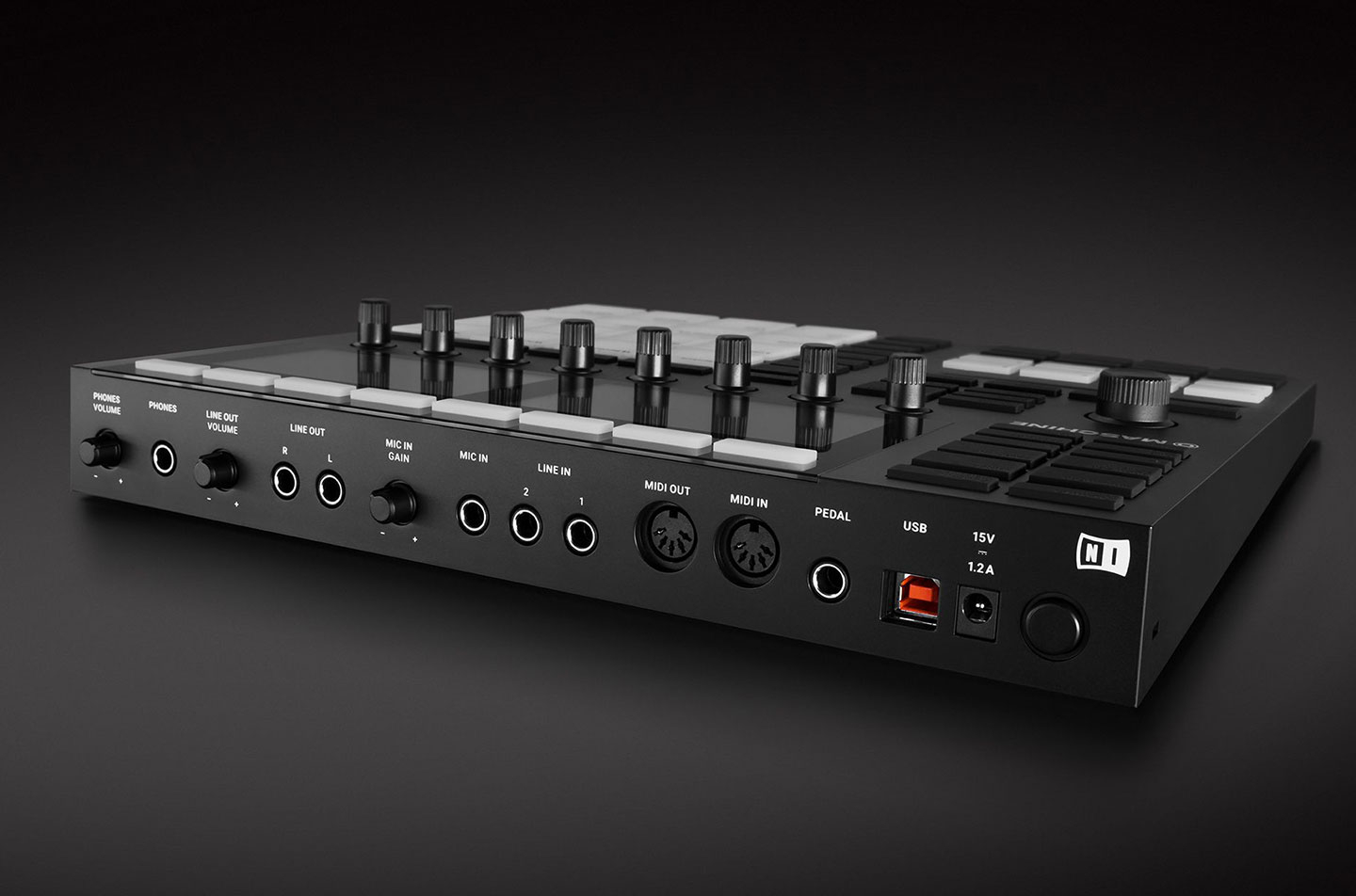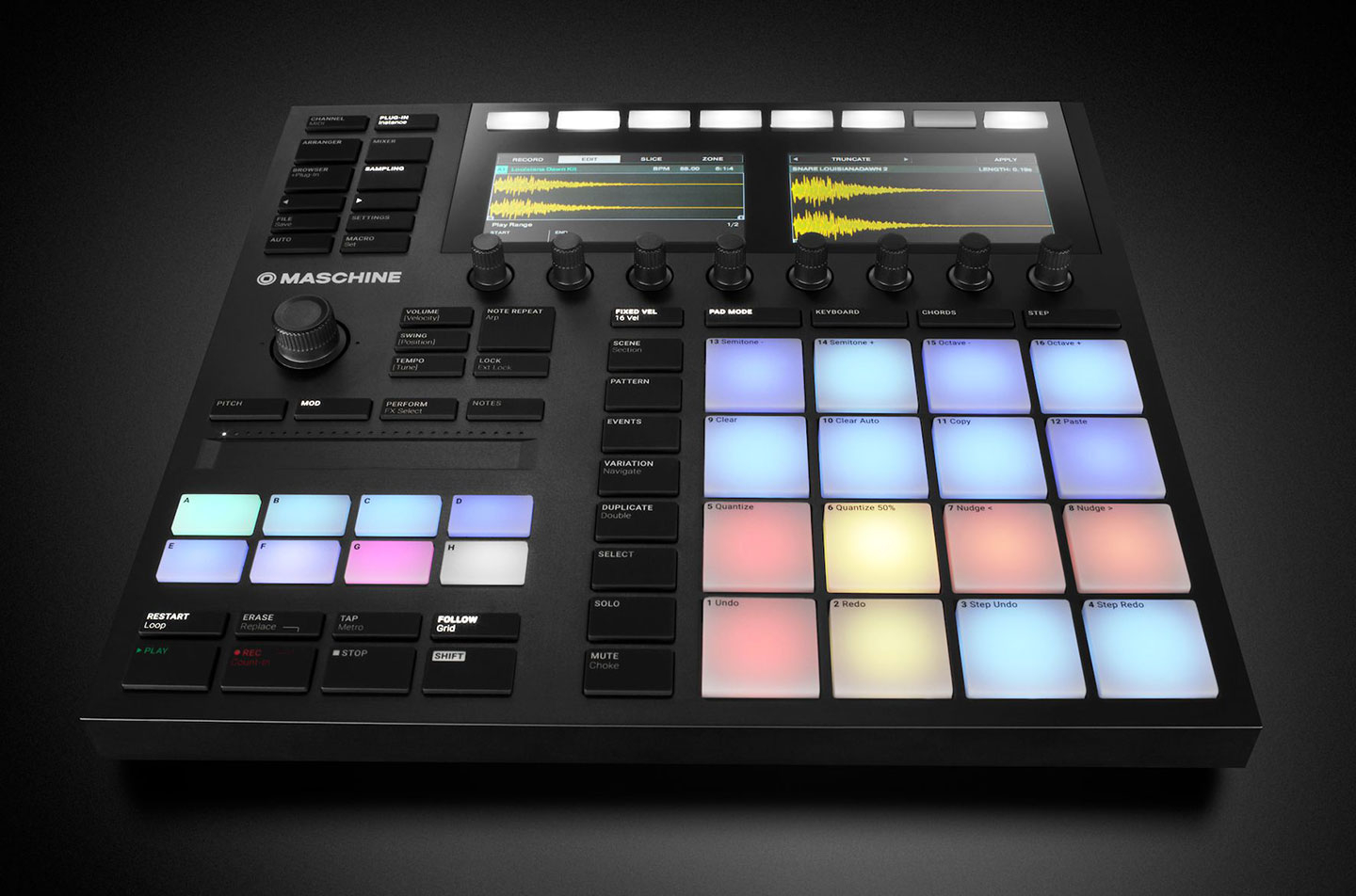- Native Instruments' Maschine Mk3 is a clear step forward for the company's flagship pad controller. While the main new feature of the last Maschine was simply RGB pad LEDs, the new version is ridden with tweaks that will be much appreciated by seasoned users. It also makes the device more accessible to those just starting out with the controller.
With Maschine Mk3, Native Instruments has assembled a feature set made up of some of the best ideas from past Maschine variants. The real standout here are upgraded high-res displays, which are pretty much everything you could want from screens on your controller—sharp, bright and fast. The screen becomes a bit dimmer when you're running off USB bus power (as opposed to the included external power supply), but it's not very noticeable and a fair tradeoff for being able to power everything off your laptop.
The Maschine Jam's Smart Strip also makes a welcome appearance. Using a ribbon strip for pitch-bend and modulation is nothing new in controller world but the Performance FX and Notes Mode both provide exciting ways to mess with patterns. When the strip is in Performance Mode, it can control any of the Performance FX's modules, leading to anything from subtle filter sweeps to ring-modding a drum group beyond recognition. In Notes Mode, the strip can be strummed like an Omnichord. This may not sound especially exciting but it's fun in practice and yields strange melodies and riffs that you might not make otherwise.
Among other, less radical, new additions is the so-called four-directional push encoder. Despite the intriguing name, this is more of a wobbly data wheel than a futuristic trackball-joystick hybrid. The main control and editing zone is dominated by this primary encoder as well as a row of eight unlabeled buttons above the displays and another eight equally anonymous encoders below. Also crucial to screen navigation is a pair of left and right navigational buttons, which are tucked away among the access buttons for things like file-saving and plug-in loading. For ergonomic's sake, it might have made more sense for them to be closer to the 4D encoder, but once you start to develop a feel for where everything is, it's not a problem.
Perhaps the most exciting new feature is the addition of a fully-integrated audio interface. On the Maschine's rear, the USB, power and MIDI jacks are now joined by dual line in- and outputs, a mic input and a separate phones output. The audio interface works well and requires only minimal configuration to get going. The one snag here is that a signal can't be mirrored by multiple outputs, which means that if you're working in headphones, you need to set the master signal to the phones output. This might be all fine if you're looking to just use headphones for cueing, but it's nonetheless strange not to have the option to monitor the main outs through the headphones and vice versa. Hopefully this will be addressed in a future update.
The Maschine software is pretty much the same as the last time we checked in, give or take a few small improvements made over the last few years. Nonetheless, the abundance of new dedicated buttons on the controller makes using the software a much more fluid process. From the get-go, the goal of the controller was to make it possible to do everything without having to look at the computer screen. Without memorising a number of complex button combinations, this isn't quite as easy as it sounds. However, with the addition of a row of Pad Mode controls across the top of the pads and a column of buttons helpful for tasks like mixing and pattern editing (not to mention the huge new LED screens), I only found myself looking at the computer when the time came to save a new project.
The pads themselves have grown to rival those of the MPC, all while maintaining the same center-to-center distance as the Maschine Mk2. The space for larger pads has been cleared by printing the pad numbers and secondary functions directly on top rather than on the controller body. For the sake of continuity, Native Instruments took this Push-like approach for all button labelling across the controller. While it works well enough with the pads, it can sometimes be tricky to make out the labels for other buttons in low-lit situations.
In practice, the Machine Mk3 is a solid and intuitive controller that shines in tandem with its powerful suite of software. New dedicated buttons like Lock, Chord Mode and one-step macro assignment make it much easier to take advantage of Maschine's best features, and the new pads are weighted with just the right amount of sensitivity. It's not the most portable controller, but then again, with a built-in audio interface, you might not need to bring anything else with you.
Ratings:
Cost: 4.0
Versatility: 4.5
Ease of use: 4.1
 The pads themselves have grown to rival those of the MPC, all while maintaining the same center-to-center distance as the Maschine Mk2. The space for larger pads has been cleared by printing the pad numbers and secondary functions directly on top rather than on the controller body. For the sake of continuity, Native Instruments took this Push-like approach for all button labelling across the controller. While it works well enough with the pads, it can sometimes be tricky to make out the labels for other buttons in low-lit situations. In practice, the Machine Mk3 is a solid and intuitive controller that shines in tandem with its powerful suite of software. New dedicated buttons like Lock, Chord Mode and one-step macro assignment make it much easier to take advantage of Maschine's best features, and the new pads are weighted with just the right amount of sensitivity. It's not the most portable controller, but then again, with a built-in audio interface, you might not need to bring anything else with you. Ratings: Cost: 4.0 Versatility: 4.5 Ease of use: 4.1
The pads themselves have grown to rival those of the MPC, all while maintaining the same center-to-center distance as the Maschine Mk2. The space for larger pads has been cleared by printing the pad numbers and secondary functions directly on top rather than on the controller body. For the sake of continuity, Native Instruments took this Push-like approach for all button labelling across the controller. While it works well enough with the pads, it can sometimes be tricky to make out the labels for other buttons in low-lit situations. In practice, the Machine Mk3 is a solid and intuitive controller that shines in tandem with its powerful suite of software. New dedicated buttons like Lock, Chord Mode and one-step macro assignment make it much easier to take advantage of Maschine's best features, and the new pads are weighted with just the right amount of sensitivity. It's not the most portable controller, but then again, with a built-in audio interface, you might not need to bring anything else with you. Ratings: Cost: 4.0 Versatility: 4.5 Ease of use: 4.1